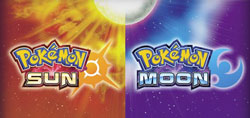Assuming one knows nothing about Pokémon: Sun and Pokémon: Moon, the most recent additions to the wildly popular Pokémon series, one might first ask, ‘what’s new?’ Well, Pokémon gyms are gone, mega-evolutions were put on the back-burner in favor of z-moves, the map is a collection of islands, the Pokémon professor is a tanned, ‘shirtless-stud’ who lets Pokémon test their attacks on him, and the new bad-guys, Team Skull, are a bunch of pun-cracking, delinquent, good-for-nothing kids who no one takes seriously. Pokémon Sun and Moon are certainly great games, however, I personally feel that this has little to do with any of the aforementioned changes, and more with the fact that they’re Pokémon titles.
Before I go into further detail about Sun and Moon, I’d like to talk a bit about my background with Pokémon. Pokémon Gold was the first video game I ever played, and at the ripe old age of seven, I spent an excess of 300 hours on the game. Since then, I’ve played at least one version of each core title and have always played the extended editions (Pokémon Yellow, Crystal, Emerald, etc.) whenever they released. I’ve played every remake of these core titles and I’ve even played most of the spinoffs with the Pokémon Colosseum and Pokémon XD: Gale of Darkness titles being my favorites in the entire series. These two GameCube spinoffs, much like Sun and Moon, ditched traditional Pokémon game format, throwing away both gyms and wild Pokémon battles/captures.
Given that my favorite titles are spinoffs which radically changed series format, I am tolerant of such an approach, perhaps even more likely than most to appreciate it. This in mind, the question becomes, what is it about Pokémon Sun/Moon that makes them less appealing? In my opinion, the changes made by Sun/Moon are jarring enough that it doesn’t feel like a core Pokémon title, yet it bears enough similarities to core titles that it doesn’t feel like a spinoff. Consider the new z-moves, which essentially replace mega-evolutions (one of the previous generation’s standout mechanics), they’re certainly cool, and they actually do a lot to balance out mega-evolution. That said, many feel that they’re a lot less interesting than mega-evolutions. Innovation is all well-and-good, but in this case, even if series patterns were altered, I wouldn’t say that there was true innovation here.
Towards the end of the game, Pokémon Moon grew on me substantially. This was due, in a large part, to the presence of the Elite Four at the title’s conclusion; even if the path to get there was different, the game did at least end on more-or-less the same terms as other core Pokémon titles. Also, though I’ve focused on Sun and Moon’s failure to innovate, these games really do have a lot going for them. The setting is at times unique and refreshing, the music nostalgic and the plot pleasantly quaint. One of the new features, Alola forms, actually does add an innovative new element to the series. Alola forms are variations of preexisting Pokémon with different types, Alola Raichu, for example, is psychic/electric (normally this species is electric), and Alola Ninetails is ice/fairy (normally fire).
Alolan variants, although technically bearing the same name/species of their precursors, beyond differing in terms of type, also have unique stats, appearances, abilities, moves, and lore. Some of these Pokémon, such as Marowak, look both similar and different from their preexisting counterparts, and as a result seem phenomenally well-designed. Then there’s a few like Dugtrio, which, aside from a blonde surfer-hairdo, appear identical to the original. Interestingly enough, only Pokémon from the original 151 Kanto list received variants, perhaps Johto will be next.
Variants like these were actually introduced by fans into community-made Pokémon games such as Pokémon Insurgence (some of which are quite good) and this feature was very popular amongst players of said games; it would appear that Game Freak (Pokémon’s Developer) has caught on to this fact and gotten in on the action. It is quite likely that regional variants of existing Pokémon will appear in future series titles. Beyond these Alola forms, most of the Alolan Pokémon were well-designed and interesting, although some may feel the pokedex was a little on the light side, with only about 80 new Pokémon.
The postgame was pretty fun; players complete a number of quests relating to legendary Pokémon. That said, while the postgame was certainly satisfactory, I felt that Omega Ruby/Alpha Sapphire’s brought more content to the table. The game’s choice not to include mega-evolutions hurt it here, as hunting for mega-evolutions greatly benefitted the previous two title’s endgames.
Pokémon games appear to be turning into an annual franchise, and after seeing what has happened to other such franchises (Assassins Creed, Call of Duty), this worries me. When a series does this, development time/resources allocated typically become more rushed for the purpose of churning out games more quickly. That said, a lot of people love Pokémon, and supply is simply adjusting to meet that demand.
As a whole, Pokémon Sun and Moon have enjoyed a very warm critical/popular reception, so clearly quality hasn’t suffered too much yet. Personally, I consider Sun and Moon to be great games; they’re very fun despite any dissatisfaction I’ve given voice to. If you’ve liked past Pokémon titles, and are trying to decide whether or not to purchase them, let me save you some trouble: yes, they are absolutely worth paying for and playing. If you liked Pokémon X/Y and want to play the same sort of thing again, then this newest generation is likely what you’re looking for, just don’t expect much more than that.
Pokémon Sun and Moon’s biggest failure, in my mind, is that in attempting to be original, a number of its supposed innovations were superfluous, and even the successes (Z-moves) don’t match with past features (mega-evolutions). That said, even if one refuses to call it innovative, it’s still a fully-functioning Pokémon game, and a worthy time-sink for any interested. In terms of rating, I’d give Pokémon Sun and Moon an 8.5/10, even if they’re not legendary Pokémon, they’re certainly top-tier competitors in the arena of video games.
IMAGE TAKEN from www.ign.com




